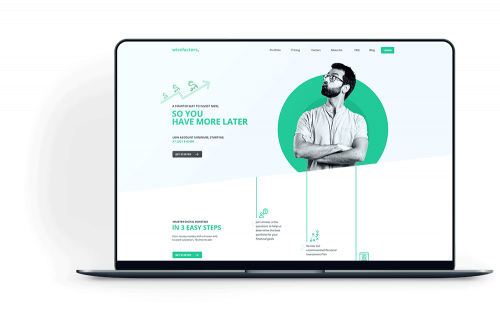How Website Design Can Help Improve User Experience and Engagement
How Website Design Can Help Improve User Experience and Engagement
Blog Article
Increase Engagement With Cutting-edge Web Site Style Solutions
A thoughtfully crafted customer experience, underpinned by calculated aesthetic style and interactive elements, can dramatically boost individual interaction. By checking out various methodologies such as receptive design and customized web content, organizations can develop a system that not just mesmerizes users however likewise cultivates long-term loyalty.

Understanding Individual Experience
Comprehending customer experience (UX) is crucial for creating reliable site style options, as it directly influences how users connect with digital platforms. A thorough UX method incorporates different components, consisting of individual, ease of access, and usability satisfaction, all of which add to the total effectiveness of a site.
To start with, functionality focuses on exactly how quickly individuals can navigate and find the info they look for. Access guarantees that all users, including those with impairments, can effectively interact with the site.
In addition, comprehending user characters is necessary for customizing the experience to fulfill particular target market demands. By carrying out user research study and screening, developers can collect understandings that notify design choices, making certain the website not only satisfies aesthetic objectives however additionally satisfies useful demands. Eventually, a thoughtful method to UX design promotes engagement, urges retention, and boosts total customer complete satisfaction, which are essential for the success of any type of electronic platform.
Visual Design Approaches
Incorporating reliable visual layout techniques is important for capturing user focus and improving the general individual experience on a website. A well-thought-out visual power structure overviews customers via the material, permitting them to conveniently take in and navigate information. This can be achieved with the calculated use of typography, color pattern, and spacing, which collectively develop a appealing and cohesive design.
Color plays an essential function in evoking emotions and developing brand identity. Using a well balanced shade palette that lines up with the brand name's ethos can promote knowledge and trust. Furthermore, including top notch pictures and graphics improves visual charm and can substantially enhance user interaction.
Whitespace, frequently forgot, is equally crucial as it allows web content to breathe and avoids frustrating users with mess. It facilitates less complicated reading and comprehension, bring about an extra pleasurable searching experience.
Last but not least, consistency in layout aspects-- such as switch designs, fonts, and symbols-- makes certain a smooth customer journey, enhancing the brand's expertise. By purposefully executing these visual style techniques, sites can not only bring in visitors however likewise encourage them to remain longer and engage even more deeply with the web content.
Interactive Elements for Engagement
Involving individuals effectively frequently hinges on the application of interactive aspects that welcome engagement and foster a dynamic surfing experience. These aspects, consisting of quizzes, surveys, and interactive infographics, urge customers to proactively get involved instead of passively consume content. By integrating such functions, internet sites can not just capture interest yet likewise boost customer retention.
Gamification is an additional effective technique. Including game-like aspects, such as success or rewards for completing jobs, can change mundane interactions into enjoyable experiences. This technique not only increases involvement but also encourages individuals to return, developing a loyal audience.
In addition, interactive components can assist in social sharing, magnifying an internet site's reach. Attributes like remark sections, share switches, and user-generated content locations foster community communication, transforming site visitors into energetic participants. website design. Inevitably, the critical usage of interactive aspects is essential for creating a interesting and compelling internet site that resonates with individuals
Receptive and Flexible Design
A well-designed internet site should prioritize flexible and responsive layout to guarantee optimum customer experiences across a selection of gadgets and display dimensions. Receptive design utilizes fluid grids and versatile pictures, allowing the design to automatically change based on the visitor's screen dimension. This strategy makes sure that individuals can easily interact and navigate with the content, no matter whether they are using a smartphone, tablet, or desktop .
In contrast, flexible layout utilizes predefined formats that are tailored to details tool groups. This means that the internet site detects the kind of gadget being used and offers the ideal layout, which can boost packing times and official statement optimize the display screen of important components. While both techniques aim to enhance usability, responsive layout is frequently preferred for its fluidness and seamless shift between tools.
Including receptive and adaptive design not only boosts customer satisfaction however also favorably impacts internet search engine rankings. Browse engines prioritize mobile-friendly websites, thus raising exposure and attracting more visitors. As a result, investing in these style techniques is crucial for businesses wanting to involve their target market efficiently and maintain an one-upmanship in today's electronic landscape.
Studying Individual Feedback and Data
Customer responses and data analysis are crucial elements of efficient web site style, as they give valuable understandings into individual actions and choices. By methodically analyzing and collecting user comments with surveys, use screening, and analytics devices, developers can determine pain points and areas for renovation. This data-driven technique enables companies to fine-tune their internet site aspects, making certain that the individual experience aligns with target market expectations.
Examining metrics such as bounce prices, time on web page, and click-through prices supplies a quantitative perspective on user engagement. These metrics aid developers determine which content reverberates and which locations might need optimization. Moreover, A/B screening can be used to examine variants in layout, permitting designers to make enlightened decisions based upon user communications.
Incorporating user comments not only enhances site functionality however also cultivates a feeling of area and count on. Involving with users through comments loops grows commitment and encourages repeat brows through. Inevitably, leveraging user responses and data analysis is indispensable to developing a dynamic, user-centered web site that adjusts to evolving individual requirements and choices, therefore driving higher interaction and satisfaction.
Final Thought

An attentively crafted user experience, underpinned by critical visual design and interactive aspects, can significantly boost user engagement.Incorporating reliable visual style methods is crucial for catching customer attention and improving the total individual experience on an internet site.User responses and data analysis are necessary parts of reliable internet site design, as a knockout post they provide beneficial insights into customer behavior and preferences. Ultimately, leveraging individual feedback and data evaluation is indispensable to creating a dynamic, user-centered web site that adjusts to developing customer requirements and preferences, thereby driving greater engagement and contentment.
In final thought, ingenious website design services dramatically improve customer interaction by prioritizing user experience, using effective aesthetic strategies, and integrating interactive elements.
Report this page